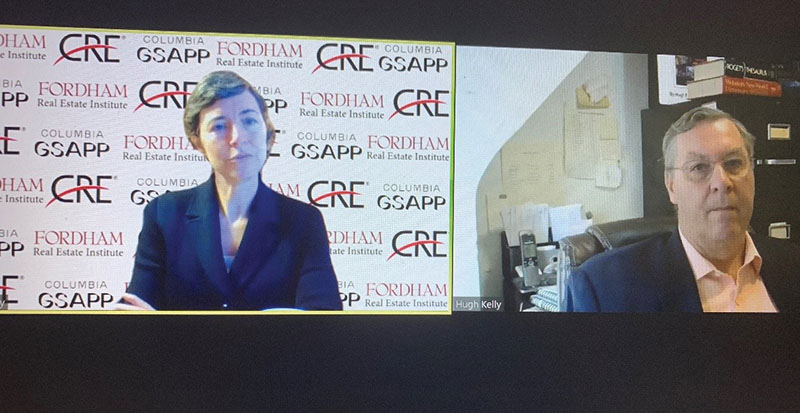Fordham Real Estate Institute, Columbia University and Counselors of Real Estate host CMBS webinar
New York, NY The Fordham Real Estate Institute (REI), the New York Metropolitan Chapter of the Counselors of Real Estate, and the Columbia Graduate of School of Architecture, Planning and Preservation hosted a virtual discussion between industry leaders about the challenges that lie ahead for the CMBS market, including the current state of the securitization market movement in key indicators.

Nearly 100 attendees participated in “Something Old, Something New, Something Borrowed, Something Blue: CMBS in 2020: Legacy Instruments, New Issuance, Underwriting Practice and Policy Issues in the COVID era.”
The event opened with remarks from Neil Madsen, principal of Madsen Advisors, who serves as the chair of the New York Metropolitan Chapter of the Counselors of Real Estate as well as a member of the Fordham REI Executive Advisory Council. Madsen introduced the fireside chat participants: Lea Overby, managing director and head of CMBS research at Wells Fargo Securities and Hugh Kelly, PhD, CRE, special advisor, Fordham REI and principal, Hugh Kelly Real Estate Economics.
The discussion began with an overview of the CMBS Market and how it has been impacted by the events of 2020, as well as how it fared during the Great Financial Crisis.
“Real estate is still leveraged at about a three to one level of debt to equity and CMBS is an important element of that, and has been for the last quarte century,” said Kelly. “It is important because it is public, which means it’s monitorable, and it gives us very timely information. And it is also sensitive in the sense that it is traded daily, and gives us a real sense of the short-term changes in the market.”
Overby presented research on the topic, including CMBS performance, delinquency rates and more prior to the start of the COVID-19 crisis. She shared that while origination volume fell initially in the months following the country’s shut down, lending has begun to improve, with the industry seeing $2.4 billion in originations, a total that is likely to rise with more new issuance coming to market. However, transaction volume has plummeted. Overby shared that transaction volumes are unlikely to increase until property investors feel more confident in valuations. The two also discussed recent underwriting trends.
“I’ve been at this game a long time, and I don’t think I can ever remember a single investor saying that they got paid to take that risk. There is always this sense that returns and risks were out of line,” said Overby. “From an investor’s perspective, they have money they have to put to work. Their job is to get as much yield as they can in the safest way that they can. Looking out there right now, CMBS does offer a compelling alternative. There have certainly been times in my life when I’ve been happy to be sitting in a researcher’s seat and not an investor’s seat, and this is one of those times.”
To view a recording of the webinar, including Overby’s research, click here (password: Z86!72jY).
The second part of the free series, “A Conversation with Brian Steinwurtzel, co-CEO of GFP Real Estate: Guiding a 16 Million Square Foot Portfolio through Turbulent Times,” took place on Thurs., Nov. 5. The event featured Brian Steinwurtzel, co-CEO and principal of GFP Properties and William Lee, CFA, CRE, senior managing director, Newmark Capital Markets. They discussed the challenges and opportunities of guiding GFP Real Estate’s 75-property, 16 million s/f portfolio through the current market turbulence. The discussion will also highlight GFP’s on-going projects including the redevelopment of 100 Pearl St., a nearly 1 million s/f office property in Manhattan’s Financial District and the firm’s move into New York’s burgeoning life sciences sector with the Innolabs project at 45-18 Court Square in Long Island City.
AmTrustRE completes $211m acquisition of 260 Madison Ave.


Strategic pause - by Shallini Mehra and Chirag Doshi

Behind the post: Why reels, stories, and shorts work for CRE (and how to use them) - by Kimberly Zar Bloorian

AI comes to public relations, but be cautious, experts say - by Harry Zlokower









.jpg)
.gif)
.gif)